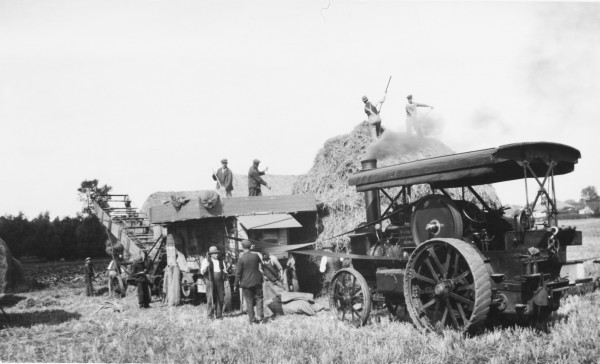- Screen Colours:
- Normal
- Black & Yellow
Beating the Ear from the Stalk

The photograph, kindly loaned to the History Group by Mr Bloomfield of Marsh Farm, is of a Garrett 4CD engine with Garrett Thresher and Elevator. Built in 1914, the engine was first sold to William Last of Stoneham Aspel. In 1923 it was bought by William Moore of Benhall, who used it for contract threshing in this area.
As many as ten men were needed to operate a steam threshing rig. The engine driver and his mate kept the engine running smoothly. A carter - usually one of the horsemen from the farm - kept the site supplied with coal and water - due to the risk of fire, threshing was usually done at a distance from the farm buildings. Two or sometimes three pitchers (one of whom might be the driver's mate) tossed the sheaves from the corn stack to another man, sometimes two men, who fed them into the turning drum. As the ears were beaten from the stalks inside the drum, the grain passed down a chute into sacks which filled up, were weighed and moved aside by the sackman. The chaff piled up out of a separate chute and was dragged away on tarpaulins by the bottom man who kept the bottom of the machine clear so that the drum continued to rotate smoothly. Two more men were needed to build the straw stack behind the threshing machine.
Threshing went on all day to the continuous throb of the steam engine and the rattle of the belts and the turning drum; it was hot work, and dirty.The workers were bombarded with flying dust, weed seeds, thistledown and other rubbish that got into the eyes and under clothing. The later the threshing, the drier and more dusty the corn. Barley dust was particularly prickly; one man now in his eighties remembers that after two days of handling the chaff from threshing barley, he and his mate could scarcely see, their eyes were so sore and reddened.
Rats provided a diversion. Corn stacks were laid on thick logs to ensure the passage of air beneath, making an ideal home for colonies of rats. Before threshing began, fine netting was laid around the bottom of the stack to contain the rats and as they gradually escaped, boys and dogs fell on them with sticks and teeth. There could be hundreds.
The era of the steam engine in agriculture was, broadly speaking, from the 1870s to the 1930s, and in that period, it was used more on big farms on the wide flat lands of the eastern counties, than on the smaller farms, with their hilly fields and narrow roads, in the west, where horse power remained dominant until the tractor was introduced. Between 1914 and 1939 the number of horses kept on farms in England and Wales fell from 885,000 to 563,000. This decline accelerated rapidly with the Second World War until the working horse almost completely disappeared from the rural landscape.
The steam-powered threshing machine had itself replaced a horse-powered machine, developed in the early 1800s. Can you imagine that for centuries before, the country was fed by grain which had been threshed by hand with a flail on the threshing floor of barns? This desperately hard work provided an income for farm labourers during the winter months. In his book, Ask The Fellows Who Cut The Hay, George Ewart Evans quotes a very old Suffolk farm worker who had used the flail in his youth, as saying “Threshing was real, downright slavery”. During the Napoleonic Wars, food prices rose sharply and farmers prospered, but their labourers suffered. Riots over the price of bread and the level of wages were common; wintertime was very hard and the workers sometimes smashed into pieces the new-fangled, horse-powered threshing machines - 390 of them in 1830 - because they made winter unemployment worse. But the flail gave way to the machine in the end and unemployed labourers and their families found work in the expanding towns.
Many thanks to Paul Chandler and colleagues at the Long Shop Museum in Leiston for identifying the engine in the photograph- one very much like it is preserved in the Long Shop. Many thanks to Richard Turner of Green Farm for helpful information. Richard estimated that nowadays a combine harvester can do, in an hour or less, the work which would have taken all day with a steam threshing rig. At the Suffolk Punch Trust Museum in Hollesley Bay, you can see and hear in action on video a threshing machine just like the one in the photograph. Well worth a visit before the winter closure!